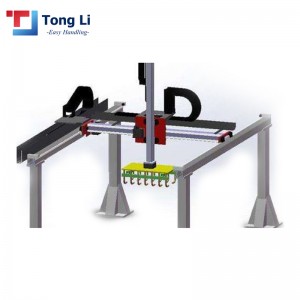With the rapid development of industrial automation, truss loading and unloading has been widely used in industrial production. As various problems will be encountered in the process of daily use of truss loading and unloading, which will cause some unnecessary losses to enterprises, then how to avoid and solve these problems? Tongli Industrial Automation Co., Ltd. is a professional manufacturer of truss manipulator with rich experience, here to share the solution tips.
1. Failure first and then debugging
For the debugging and fault coexistence of electrical equipment, should first troubleshoot, and then debug, debugging must be carried out in the case of normal electrical wiring.
2. First outside and then inside
Should first check the surface of the equipment for obvious cracks, defects, to understand its maintenance history, years of use, etc., and then the internal inspection of the machine. Before demolition should exclude the surrounding fault factors, to determine the fault for the machine before demolition, otherwise, blind demolition, may repair the equipment more and more bad, causing unnecessary losses.
3. Mechanical parts first and then electrical parts
Only after the mechanical parts are determined to be fault-free, then the electrical aspects of the inspection. Check the circuit failure, you should use the detection instrument to find the fault site, to confirm that no poor contact failure, and then targeted view of the line and mechanical operation of the relationship to avoid misjudgment.
4. Replacement of electrical parts, first peripheral and then internal
Do not rush to replace the damaged electrical parts of the truss robot first, and then consider replacing the damaged electrical parts when confirming the peripheral equipment circuit is normal.
5. Daily maintenance, DC first and then AC
When inspecting, you must check the static working point of DC circuit first, and then check the dynamic working point of AC circuit.
6. Failure, first mouth and then hands for faulty truss loading and unloading electrical equipment, not emergency hands, should first ask the fault before and after and the fault phenomenon. For the rusty equipment, should also be familiar with the circuit principle and structural characteristics first, comply with the corresponding rules. Before disassembly, be fully familiar with the function, location, connection and relationship with other devices around of each electrical component, and in the absence of assembly diagram, draw sketch and mark while disassembling.
7. Static first and then dynamic
When the truss manipulator is not energized, judge the electrical equipment buttons, contactors, thermal relays and fuses so as to determine where the fault lies. Power on the test, listen to its sound, measure the parameters, determine the fault, and finally repair. For example, when the motor is out of phase, if the measurement of the three-phase voltage value can not be discerned, you should listen to its sound and measure the voltage of each phase separately to determine which phase is defective.
8. Maintenance, first clean and then repair
For heavily polluted electrical equipment, first clean its buttons, junction points, contact points, and check whether the external control keys are out of order. Many failures are caused by dirty and conductive dust block, once clean failure will often be eliminated.
9. First power supply after the equipment daily truss loading and unloading power supply part of the failure rate in the whole failure equipment accounted for a high proportion, so first overhaul power supply can often get twice the result with half the effort.
Post time: Dec-16-2021


